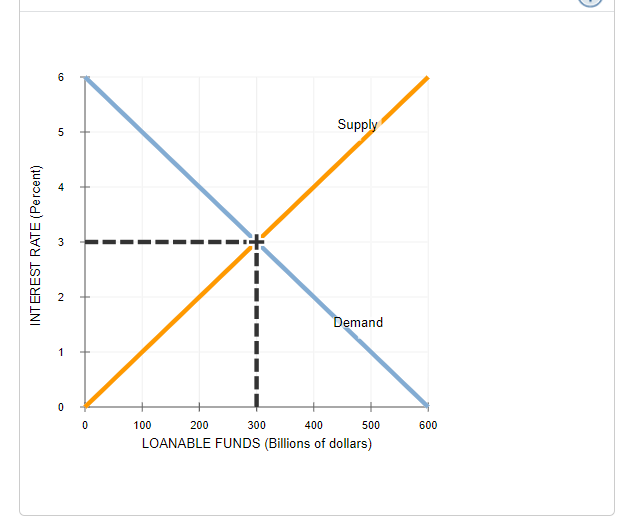Supply and demand for loanable funds The following graph shows the market for loanable funds in a closed economy. The upward-sloping orange line represents the supply of loanable funds, and the downward-sloping blue line represents the demand for loanable funds. _____(saving/investment) is the source of the supply of loanable funds. As the interest rate falls, the quantity of loanable funds supplied ______(decrease/increase). Suppose the interest rate is 2.5%. Based on the previous graph, the quantity of loanable funds supplied is ______(greater/less) than the quantity of loans demanded, resulting in a ______(surplus/shortage) of loanable funds. This would encourage lenders to ______(raise/lower) the interest rates they charge, thereby ______(increasing/decreasing) the quantity of loanable funds supplied and _______(increasing/decreasing) the quantity of loanable funds demanded, moving the market toward the equilibrium interest rate of ________%(how many percent). Note:- Everything written in bold handwriting is the option for the question. So please give all the correct answers to this problem. Also, the graph (in the image) is for help and tells how many percent for the last answer.
Supply and demand for loanable funds The following graph shows the market for loanable funds in a closed economy. The upward-sloping orange line represents the supply of loanable funds, and the downward-sloping blue line represents the demand for loanable funds. _____(saving/investment) is the source of the supply of loanable funds. As the interest rate falls, the quantity of loanable funds supplied ______(decrease/increase). Suppose the interest rate is 2.5%. Based on the previous graph, the quantity of loanable funds supplied is ______(greater/less) than the quantity of loans demanded, resulting in a ______(surplus/shortage) of loanable funds. This would encourage lenders to ______(raise/lower) the interest rates they charge, thereby ______(increasing/decreasing) the quantity of loanable funds supplied and _______(increasing/decreasing) the quantity of loanable funds demanded, moving the market toward the equilibrium interest rate of ________%(how many percent). Note:- Everything written in bold handwriting is the option for the question. So please give all the correct answers to this problem. Also, the graph (in the image) is for help and tells how many percent for the last answer.
Chapter1: Making Economics Decisions
Section: Chapter Questions
Problem 1QTC
Related questions
Question
4. Supply and demand for loanable funds
The following graph shows the market for loanable funds in a closed economy. The upward-sloping orange line represents the supply of loanable funds, and the downward-sloping blue line represents the demand for loanable funds.
_____(saving/investment) is the source of the supply of loanable funds. As the interest rate falls, the quantity of loanable funds supplied ______(decrease/increase).
Suppose the interest rate is 2.5%. Based on the previous graph, the quantity of loanable funds supplied is ______(greater/less) than the quantity of loans demanded, resulting in a ______(surplus/shortage) of loanable funds. This would encourage lenders to ______(raise/lower) the interest rates they charge, thereby ______(increasing/decreasing) the quantity of loanable funds supplied and _______(increasing/decreasing) the quantity of loanable funds demanded, moving the market toward the equilibrium interest rate of ________%(how many percent).
Note:- Everything written in bold handwriting is the option for the question. So please give all the correct answers to this problem. Also, the graph (in the image) is for help and tells how many percent for the last answer.

Transcribed Image Text:6
Supply
Demand
1
100
200
300
400
500
600
LOANABLE FUNDS (Billions of dollars)
INT EREST RATE (Percent)
Expert Solution
This question has been solved!
Explore an expertly crafted, step-by-step solution for a thorough understanding of key concepts.
This is a popular solution!
Trending now
This is a popular solution!
Step by step
Solved in 2 steps with 1 images

Knowledge Booster
Learn more about
Need a deep-dive on the concept behind this application? Look no further. Learn more about this topic, economics and related others by exploring similar questions and additional content below.Recommended textbooks for you


Principles of Economics (12th Edition)
Economics
ISBN:
9780134078779
Author:
Karl E. Case, Ray C. Fair, Sharon E. Oster
Publisher:
PEARSON

Engineering Economy (17th Edition)
Economics
ISBN:
9780134870069
Author:
William G. Sullivan, Elin M. Wicks, C. Patrick Koelling
Publisher:
PEARSON


Principles of Economics (12th Edition)
Economics
ISBN:
9780134078779
Author:
Karl E. Case, Ray C. Fair, Sharon E. Oster
Publisher:
PEARSON

Engineering Economy (17th Edition)
Economics
ISBN:
9780134870069
Author:
William G. Sullivan, Elin M. Wicks, C. Patrick Koelling
Publisher:
PEARSON

Principles of Economics (MindTap Course List)
Economics
ISBN:
9781305585126
Author:
N. Gregory Mankiw
Publisher:
Cengage Learning

Managerial Economics: A Problem Solving Approach
Economics
ISBN:
9781337106665
Author:
Luke M. Froeb, Brian T. McCann, Michael R. Ward, Mike Shor
Publisher:
Cengage Learning

Managerial Economics & Business Strategy (Mcgraw-…
Economics
ISBN:
9781259290619
Author:
Michael Baye, Jeff Prince
Publisher:
McGraw-Hill Education